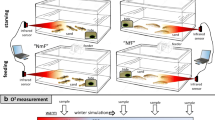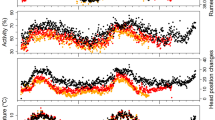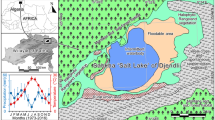Summary
-
1.
The daily (circadian) rhythm of activity and rest of common redpolls (Acanthis f. flammea L.) from 65°N lat. was measured for about one year in individuals outdoors at two latitudes (48° and 65°N). During winter at both latitudes, activity-time (α) of common redpolls approximated the duration of daylight (including civil twilights); onset of activity, however, occurred at lower light intensities than end of activity. During mid-summer, a rest-time (p) of ca. 5 h was maintained at both latitudes. During the times of spring and fall migration (extending into summer or winter, respectively), common redpolls showed nightly unrest or shifted their onset of daily activity into the pre-dawn hours.
-
2.
Redpolls of two subspecies (A. f. flammea and A. f. cabaret Müller) resident at different latitudes (ca. 65° and 49°N) were maintained and measured under the same light conditions at 48°N lat. The two populations showed significant differences in their responses to the same annual changes in day length which included: (i) differences in the timing of the circadian activity rhythm with respect to the daily solar cycle; (ii) differences in the amount and range of seasonal changes in nightly unrest; (iii) differences in the mean level and range of seasonal changes of body weight; and (iv) differences in the timing of postnuptial molt.
-
3.
In all experimental groups of redpolls, the highest “precision” (i.e. lowest mean day-to-day variation) in onset and end of activity was observed when both phases occurred during the twilights. The different effects of annually changing light conditions on onset and end of activity with respect to solar time indicated that timing of these two phases of the activity rhythm is independently controlled. It is further indicated that an annually changing sensitivity to light controls the termination of activity in common redpolls, although ambient temperature can modify this response.
-
4.
Besides the direct influence of latitude on timing and the amount of changes of various circadian and annual functions throughout the year, the important role of long-term (genetic?) adaptation to the light and temperature conditions prevailing in the respective habitats of redpoll populations is emphasized by the results of this study.
Similar content being viewed by others
References
Aschoff, J.: Phasenlage der Tagesperiodik in Abhängigkeit von Jahreszeit und Breitengrad. Oecologia (Berl.) 3, 125–165 (1969)
Aschoff, J., Daan, S., Figala, J., Müller, K.: Precision of entrained circadian activity rhythms under natural photoperiodic conditions. Naturwissenschaften 59, 276–277 (1972)
Aschoff, J., Gwinner, E., Kureck, A., Müller, K.: Diel rhythms of chaffinches Fringilla coelebs L., tree shrews Tupaia glis L. and hamsters Mesocricetus auratus L. as a function of season at the Arctic Circle. Oikos (Suppl.) 13, 91–100 (1970)
Aschoff, J., Wever, R.: Beginn und Ende der täglichen Aktivität freilebender Vögel. J. Orn. 103, 2–27 (1962)
Baldwin, P.H.: Hoary Redpoll. In: Life histories of North American Cardinals, Grosbeaks, Buntings, Towhees, Finches, Sparrows, and Allies (O.L. Austin, Jr., ed.). U.S. Nat. Mus. Bull. 237 (1), 400–407 (1968)
Bezzel, E.: Zum Brutvorkommen des Birkenzeisigs (Carduelis flammea) im Bayerischen Wald und Böhmerwald. Ann. Orn. Ges. Bayern 7, 343–344 (1965)
Clement, R.C.: Common Redpoll. In: Life histories of North American Cardinals, Grosbeaks, Buntings, Towhees, Finches, Sparrows, and Allies (O.L. Austin, Jr. ed.). U.S. Nat. Mus. Bull. 237 (1), 407–421 (1968)
Daan, S., Aschoff, J.: Circadian rhythms of locomotor activity in captive birds and mammals: Their variations with season and latitude. Oecologia (Berl.) 18, 269–316 (1975)
Erkinaro, E.: Wirkung der Tageslänge und Dämmerung auf die Phasenlage der 24 h-Periodik der Waldmaus Apodemus flavicollis Melch. im Naturtag. Oikos (Suppl.) 13, 101–107 (1970)
Erkinaro, E.: Seasonal changes in the phase position of circadian activity rhythms in some voles, and their endogenous component. Aquilo, Ser. Zool. 13, 87–91 (1972a)
Erkinaro, E.: Precision of the circadian clock in Tengmalm's owl, Aegolius funereus (L.) during various seasons. Aquilo, Ser. Zool. 13, 48–52 (1972b)
Erkinaro, E.: Structure of the diel activity period in Tengmalm's owl, Aegolius funereus, and the short-eared owl, Asio flammeus, and its seasonal changes. Aquilo, Ser. Zool. 14, 59–67 (1973)
Evans, P.R.: Autumn movements, moults and measurements of the lesser redpoll, Carduelis flammea cabaret. Ibis 108, 183–216 (1966)
Gwinner, E.: Untersuchungen zur Jahresperiodik von Laubsängern. III. Die Entwicklung des Gefieders, des Gewichts und der Zugunruhe südwestdeutscher und skandinavischer Fitisse (Phylloscopus trochilus trochilus und Ph. t. acredula) J. Orn. 113, 108 (1972)
Gwinner, E.: Circannual rhythms in birds: Their interaction with circadian rhythms and environmental photoperiod. J. Reprod. Fertil., Suppl. 19, 51–65 (1973)
Kenagy, G.J.: The periodicity of daily activity and its seasonal changes in free-ranging and captive kangaroo rats. Oecologia (Berl.) 24, 105–140 (1976)
Laufens, G.: Freilanduntersuchungen zur Aktivitätsperiodik dunkelaktiver Säuger. Diss., Math.-Nat. Fak. Köln (1972)
Laufens, G.: Beginn und Ende der täglichen Aktivität freilebender Haselmäuse (Muscardinus avellanarius L.) und Siebenschläfer (Glis glis L.). Z. Säugetierkunde 40, 74–89 (1975)
Matousek, B.: Hniezdenie stehlikov cecetavych (Carduelis flammea) na Slovensku. Zb. Slov. Nar. Muz. 14, 153–157 (1968)
Newton, I.: Moults and weights of captive redpolls Carduelis flammea. J. Orn. 110, 53–61 (1969)
Peiponen, V.A.: Südliche Fortpflanzung und Zug von Carduelis flammea (L.) im Jahre 1965. Acta Zool. Fenn. 4, 547–559 (1967)
Pittendrigh, C.S.: Circadian surfaces and the diversity of possible roles of circadian organization in photoperiodic induction. Proc. Nat. Acad. Sci. (Wash.) 69, 2734–2737 (1972)
Pohl, H.: Seasonal change in light sensitivity in Carduelis flammea. Naturwissenschaften 59, 518 (1972)
Pohl, H.: Circadian rhythms of metabolism in Cardueline finches as function of light intensity and season. Comp. Biochem. Physiol. (in press)
West, G.C.: Bioenergetics of captive willow ptarmigan under natural conditions. Ecology 49, 1035–1045 (1968)
West, G.C., Peyton, L.J., Savage, S.: Changing composition of a redpoll flock during spring migration. Bird-Banding 39, 51–55 (1968)
West, G.C., Pohl, H.: Effect of light-dark cycles with different LD time-ratios and different LD intensity-ratios on the activity rhythm of chaffinches. J. comp. Physiol. 83, 289–302 (1973)
Author information
Authors and Affiliations
Additional information
An expanded version of a presentation made at the VII International Biometeorological Congress held at College Park, Maryland, USA, in August 1975 and at a Meeting of the Alexandervon-Humboldt Stiftung at Erling-Andechs, Federal Republic of Germany, in September 1975
Rights and permissions
About this article
Cite this article
Pohl, H., West, G.C. Latitudinal and population specific differences in timing of daily and seasonal functions in redpolls (Acanthis flammea). Oecologia 25, 211–227 (1976). https://doi.org/10.1007/BF00345099
Received:
Issue Date:
DOI: https://doi.org/10.1007/BF00345099




